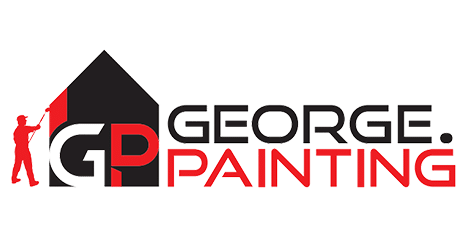
Painting might seem like a pretty easy DIY at the start, but some people fail to realise how complex it can be, leading to a poor attempt without expert knowledge. Knowing when to hire a professional painter can mean the difference between a sloppy job and a lasting, beautiful finish.
Here at George Painting, we’ve got over 50 years of experience, and we’ve seen our fair share of dodgy DIYs. We’re here to show you some clear signs when you need a painter, the advantages a professional brings and the mistakes that should be avoided along the way.
The Right Time to Hire a Painter
Certain situations need expert help, and you can save plenty of time and money by knowing when to call a professional painter from the start.
Peeling, cracking, or fading paint
Peeling, cracking, flaking, and stained surfaces aren’t just about looks; they show your paint no longer protects your property from moisture and weather. This is particularly problematic in coastal areas where your home needs all the protection it can get from harsh sun and salty air.
Many of these problems usually come from poor surface prep or using the wrong paint type, so it pays to consult the experts.
Upcoming renos or property sale
Fresh paint can improve your property’s appeal if you plan to sell. New paint helps buyers focus on your home’s features instead of small damages that make it look worn out. You don’t even have to repaint every interior and exterior surface; sometimes just a few walls or rooms will suffice. And while painting before selling costs money, a professional job with a quality result can increase your market value and make the project worthwhile.
Hard-to-reach or hazardous areas
High ceilings, tall stairwells, and multi-storey exteriors pose hard access and safety risks. Professional painters know how to work at heights and bring proper access equipment and safety gear. They also handle special cases, like lead-based paint or mould, according to safety rules. Trying to handle these jobs without the right experience means a high risk of injury if things go wrong and a health threat if the correct procedure is not followed.
Why Professional Painters Deliver Better Results
Professional painters bring skills and knowledge that DIYers just can’t match. You can see and measure the difference in how long it lasts and how it looks.
Trained in surface preparation and application
Professional painters know that good surface prep is the foundation of every great paint job. They clean every surface carefully, fix any cracks or flaws, and use the right primers before painting begins. All of that detailed prep helps paint stick better and makes your paint job last longer. This experience is invaluable for creating perfect finishes.
Access to high-quality tools and materials
Professional painters invest in quality equipment that delivers amazing results:
- Premium brushes and rollers
- Pro-grade sprayers
- Special ladders, framework, and safety gear
- Prep tools like sanders and fillers
On top of that, they use premium paints from trusted brands that match your project’s needs. These high-end materials cover better, last longer, and look nicer than regular store-bought paint. You can trust the pros to know the best type of paint for every different space and situation to give you great results.
Expertise in colour selection and finishes
If you don’t know the right colour for your space, the choices can seem overwhelming. Professional painters understand how various finishes influence the final appearance and will recommend a few choices based on your vision. They also consider all relevant factors such as sheen level, different finishes, surface texture, lighting, furniture, flooring, and more to ensure optimal results.
Here at George Painting, our local Dulux Accredited colour consultant takes care of this for you. We’ll assist you in selecting shades that enhance your space and create the desired atmosphere. And if you’re having trouble visualising the options, our colour overlay service shows you what they look like on pictures of your home to give you an idea of the finished result.
Avoiding Common DIY Mistakes
Paint projects can quickly turn into nightmares despite your best intentions. You can save time, money, and headaches by staying clear of these common mistakes.
Underestimating the scope of work
You might start off thinking it’ll be a simple weekend project, and before you know it, that job has stretched into weeks. Wall touch-ups rarely match your existing paint because sunlight and dust change wall colours over time. Your small patch-up job might force you to repaint the entire wall or the entire room.
The paint also needs proper drying time between coats, and rushing the second coat leads to uneven colours, streaks, or peeling paint. Paint manufacturers might promise one-coat coverage, but professional results usually need at least two coats.
Using low-quality or mismatched materials
Cheap paint seems like a money-saver at first, but hidden costs add up fast:
- Cheaper paints typically offer less coverage, requiring additional coats.
- Budget paints tend to fade fast. They are also prone to staining and are difficult to clean.
- Applying a coat of budget paint requires the same preparation and application effort as premium paint, but it doesn’t last as long.
And that’s all before you consider the time and effort involved. Budget paints just won’t last as long, meaning you’ll repaint every 3-5 years instead of 10-15 years with premium products.
Skipping necessary steps and using the wrong products:
Skipping critical steps in the process often leads to significant work later to fix issues that will emerge. Below is a list provided by George of the most frequently overlooked steps when trying to save time or cost:
Woodwork:
- Repainting existing oil-based coated woodwork with a water-based product without doing enough sanding, and not using an oil-based primer first
- Not sealing the top and bottom of the doors, especially in wet areas
- Using the wrong roller
- Not using primer when painting new preprimed woodwork, especially when using water-based topcoats.
Interior walls and ceilings:
- Doing minimal preparations
- Applying standard ceiling paint over flaky ceilings or water-damaged ceilings
- Not using a proper stain blocker when repainting stained surfaces
- Painting over mouldy surfaces
- Not priming patchwork
Exterior:
- Failing to wash and clean the surfaces
- Not using the correct primer over old weatherboards, especially over old enamel paint
- Skipping the primer/undercoat on new or bare or preprimed surfaces, as most multipurpose premium paint is advertised as “self-priming on most surfaces”
- Failing to recognise the need for protective coating on steelwork and applying specially on waterfront properties
- Applying standard exterior paint straight over powder-coated surfaces
Skipping safety protocols and cleanup
Painting jobs come with serious hazards, including fire risks from flammable solvents and harmful vapours that can build up without good airflow in your workspace.
Paint waste poses environmental risks when disposed of incorrectly. You need to treat them as household hazardous waste and never pour solvent-borne paints down drains or onto soil.
What to Look for When Hiring a Professional Painter
Picking the right professional painter means more than just looking at prices. Your choice will affect the quality of work and your legal protection throughout the project.
Licensing, insurance, and safety compliance
Licensed painters ensure quality and give you more legal protection. Working with unlicensed contractors puts you at risk because you won’t be able to recover damages for poor workmanship. Professional painters also keep you safe from financial responsibility if accidents or property damage happen during the project, since they need to carry public liability insurance and workers’ compensation coverage. You should always ask to see proof of these credentials before moving forward with any contractor.
Transparent quotes, detailed scope of work and clear timelines
Written quotes help everyone understand what to expect from the project. A detailed quote needs to include paint brand specifications, preparation details, areas to be painted, total costs, and payment terms.
Professional painters need to explain clearly how surface preparation and drying times between coats might change the timeline.
Customer reviews and past project examples
Looking at past work is a great way to get insights into a painter’s reliability and quality. Keep an eye on reviews on Google, Facebook, and industry directories to see what past customers have to say. Good painters will happily show you their portfolio of previous projects and client references. Star ratings and verified testimonials help you spot excellent contractors and avoid the bad ones. Look for detailed reviews that talk about specific parts of the completed work.
Warranties and post-job support
Confident professional painters back their work with solid guarantees. NSW requires a minimum 6-month warranty for workmanship, but most painters offer more. Be careful of painters who offer less coverage than this standard. Written warranties must clearly state what’s covered (like peeling, cracking, or bubbling) and what’s not. This protection gives you peace of mind and shows the painter’s confidence in their work.
Work with a Professional Painter You Can Trust
At George Painting, we bring our expertise to every job, whether it’s a simple feature wall or a whole-home renovation. There are plenty of reasons to go with a professional to give your job an even finish and long-lasting results.
Projects can get pricey if you underestimate the work needed, use cheap materials, or work in unsafe conditions. Skip the guesswork and let us handle the details. Reach out to us for tailored advice and a free quote.
